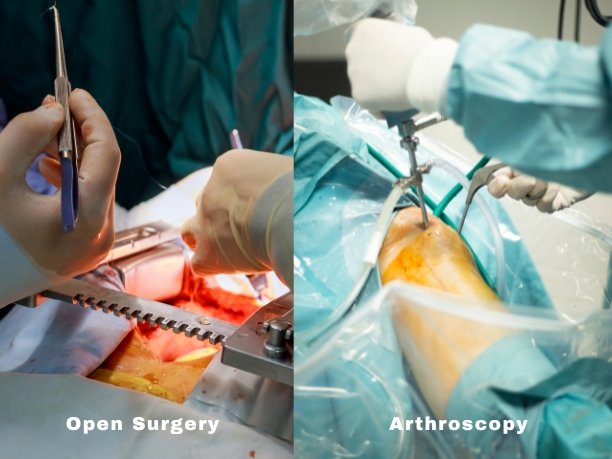Arthroscopy or Open Surgery: Which is the Better Choice for Joint Treatment?

When it comes to joint treatment, choosing the right surgical approach is crucial for long-term recovery and overall well-being. Two common procedures used for joint repair and treatment are Arthroscopy and Open Surgery. Each has its benefits and risks, and the best option depends on various factors such as the severity of the condition, patient age, and lifestyle.
What is Arthroscopy?
Arthroscopy is a minimally invasive surgical procedure used to diagnose and treat joint problems. The procedure involves inserting a small camera, called an arthroscope, into the joint through a tiny incision. The camera projects images onto a screen, allowing the arthroscopy specialist to guide specialized instruments and perform necessary repairs with precision.
Benefits of Arthroscopy
1. Minimally Invasive – Small incisions reduce scarring and minimize tissue damage.
2. Faster Recovery – Less disruption to surrounding tissues leads to a quicker healing process.
3. Lower Risk of Infection – Smaller wounds reduce the chances of post-surgical infections.
4. Less Pain – Patients typically experience less postoperative pain compared to open surgery.
5. Outpatient Procedure – Many arthroscopic surgeries do not require hospital stays, allowing patients to return home the same day.
Common Conditions Treated with Arthroscopy
- Torn meniscus in the knee
- Rotator cuff injuries in the shoulder
- Ligament repairs (such as ACL and PCL injuries)
- Cartilage damage
- Joint inflammation or infection
What is Open Surgery?
Open surgery, also known as traditional surgery, involves making a large incision to access and repair the joint directly. This technique allows the joint replacement specialist to have a full view of the joint and surrounding structures.
Benefits of Open Surgery
1. Better Access to the Joint – Open surgery provides a comprehensive view of the joint, allowing for detailed repairs.
2. Effective for Complex Cases – Used for severe injuries or cases where arthroscopy is not sufficient.
3. Long-Term Durability – Open surgery is often preferred for joint replacement procedures, ensuring stability and long-term success.
4. More Effective for Bone and Ligament Reconstruction – Some conditions, such as severe fractures, require direct manipulation and fixation.
Common Conditions Treated with Open Surgery
- Total and partial joint replacements (knee, hip, shoulder)
- Severe ligament tears that require open reconstruction
- Large rotator cuff repairs
- Complex fractures
- Advanced osteoarthritis requiring bone reshaping or prosthetic implants
Arthroscopy vs. Open Surgery: A Detailed Comparison
| Feature | Arthroscopy | Open Surgery |
| Invasiveness | Minimally invasive | More invasive |
| Recovery Time | Faster recovery (weeks) | Longer recovery (months) |
| Pain Level | Less postoperative pain | More pain due to larger incisions |
| Hospital Stay | Often outpatient | May require hospital stay |
| Scarring | Minimal scars | Larger, more visible scars |
| Risk of Infection | Lower | Higher due to larger incisions |
| Cost | Generally lower | Can be more expensive due to a longer hospital stay |
How to Choose Between Arthroscopy and Open Surgery
Selecting the best treatment method depends on several factors. Consulting with an arthroscopy specialist or joint replacement specialist can help determine which approach is suitable based on the following considerations.
1. Severity of the Joint Condition
- Mild to moderate injuries such as small cartilage tears and mild arthritis often respond well to arthroscopy.
- Severe damage, including major fractures or advanced arthritis, may require open surgery.
2. Patient’s Age and Activity Level
- Young and active patients benefit more from arthroscopy due to its faster recovery time.
- Older adults with degenerative joint diseases might need open surgery for long-term relief and stability.
3. Recovery Goals
- If you need quick recovery (e.g., athletes), arthroscopy is often the preferred choice.
- If complete joint reconstruction is needed, open surgery might be necessary.
4. Previous Treatments and Medical History
- Patients who have undergone multiple surgeries or have complex conditions may require open surgery.
- Those with no prior joint issues and mild damage may benefit from arthroscopy.
Recovery After Arthroscopy vs. Open Surgery
Recovery plays a significant role in determining which procedure is right for you. Here’s what to expect:
Recovery After Arthroscopy
- Day of Surgery: Most patients can go home the same day.
- First Week: Mild swelling and discomfort are common but manageable with pain medication.
- 2-6 Weeks: Physical therapy begins to restore joint function.
- 3 Months: Many patients return to normal activities.
Recovery After Open Surgery
- Hospital Stay: May require 1-5 days in the hospital.
- First Few Weeks: Swelling, pain, and limited movement are common.
- Physical Therapy: Starts early but progresses slowly to avoid complications.
- 6-12 Months: Full recovery for major surgeries like joint replacements.
Both arthroscopy and open surgery have their advantages, and the right choice depends on the individual’s condition, age, and treatment goals. Consulting with an arthroscopy and joint replacement specialist is essential to evaluate the severity of the joint problem and decide the most effective treatment.